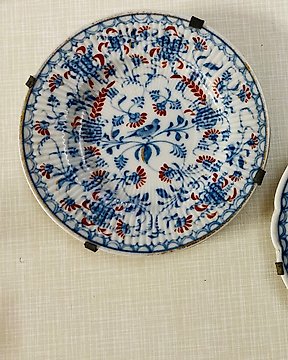
Rauenstein - Gotthelf Greiner - Wall plate (2) - Porcelain
No. 83980519

No. 83980519

Very rare Meissen porcelain plate from the early dot period - Punktzeit (1756-1774). It has a unique relief pattern as well as floral decoration and its irregular and very thin shape suggests that it is an experimental object or one made by an apprentice. The plate has three small holes caused by the firing process, which are covered by small painted leaves. The dot between the swords indicates a design by Carl Christoph Punkt, who joined the Meissen manufactory in 1762, at the end of the Seven Years' War. The floral decoration is possibly the work of Christian Wilhelm Ernst Dietrich, who had been artistic director of the Meissen manufactory since 1765. As the sword mark is not accompanied by any other letters, the plate can probably be dated to the early Punktzeit. Stylistically, the plate fits into this period, as it combines decorative elements from the Rococo period with a simplification of forms typical of early Neoclassicism.
Due to its incredible age of over 250 years, the painted flowers in the center show some minor damage.
The item is packaged to prevent breakage and will be sent with tracking and insured shipping.
Deutsch:
Sehr seltener Meissener Porzellanteller aus der frühen Punktzeit (1756-1774). Er hat ein einzigartiges Reliefmuster und Blumendekor. Seine unregelmäßige und sehr dünne Form lässt vermuten, dass es sich um ein Versuchsobjekt oder ein von einem Lehrling hergestelltes Objekt handelt. Der Teller weist drei kleine Löcher auf, die durch den Brennvorgang entstanden sind und durch kleine gemalte Blätter verdeckt werden. Der Punkt zwischen den Schwertern deutet auf einen Entwurf von Carl Christoph Punkt hin, der 1762, am Ende des Siebenjährigen Krieges, in die Meissener Manufaktur eintrat. Der florale Dekor stammt möglicherweise aus der Hand von Christian Wilhelm Ernst Dietrich, der seit 1765 künstlerischer Leiter der Meissener Manufaktur war. Da die Schwertermarke von keinen weiteren Buchstaben begleitet wird, ist der Teller wahrscheinlich in die frühe Punktzeit zu datieren. Stilistisch passt der Teller in diese Zeit, da er dekorative Elemente aus dem Rokoko mit einer für den frühen Neoklassizismus typischen Vereinfachung der Formen verbindet.
Aufgrund seines unglaublichen Alters von über 250 Jahren weisen die gemalten Blumen in der Mitte einige kleine Beschädigungen auf.
Der Artikel wird bruchsicher verpackt und mit Sendungsverfolgung und versichertem Versand verschickt.
How to buy on Catawiki
1. Discover something special
2. Place the top bid
3. Make a secure payment